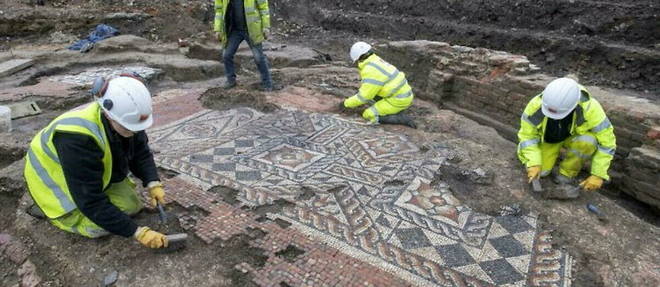Roman mosaic discovered in London on the right bank of The Thames

It was until recently a large car park located on the right bank of the River Thames at the intersection of Southwark Street and Redcross Way. The Landmark Court site, under construction for several months to accommodate a cultural complex, as well as residential buildings and shops, has been delivering a succession of archaeological treasures since last fall.
An exceptional mosaic has just been unearthed there. Dated between the year 175 and 225 of the Christian era, it testifies to the existence in this place of a vast Roman villa. “It’s the kind of discovery you make once in your life,” enthuses Antonietta Lerz, of the Archaeological Museum of London (MOLA). Elements of the ground, found lower down, suggest an even older habitation site.
The presence in this place of ancient ruins does not surprise specialists. In the same area, the foundations of a vast building from the Roman era had already been found during the extension of a metro line (the Jubilee Line) in 1981. The mosaic currently unearthed is, however, the first to be identified in this area. She would have paved the floor of a dining room, explain the specialists.
Several pieces of wall have also been discovered on site since last October. They were covered with plaster and painted with colorful patterns. They have been fully digitized to establish a 3D rendering of the building. A succession of columns suggests that this rectangular building of 13 meters by 10 had several floors.
The excavations revealed a ceramic pot intentionally buried near the entrance door of the construction, perhaps in a ritual context of protection of the place. Oyster shells, coins dating back to the first century AD, but also copper bowls and jewelry (including a bronze brooch) were also found on site. A games counter and a pendant decorated with phallic motifs suggest that the place hosted Roman legionnaires.
Some of the pieces identified, dated between 60 and 120 AD, constitute contemporary evidence of the refoundation of the Roman colony of Londinium. The oldest traces of urbanization found in the British capital date back to the year 47. The initial hamlet, founded by Queen Boudicca (or Boadicée), was destroyed by fire and rebuilt around 65.
This hearth was not long in developing since at the turn of the first century Londinium counted among the most important cities of the Roman province of Britannia with Camulodunum (Colchester). The village was then transformed into a major urban center, reaching 50,000 inhabitants during the 2nd century of the Christian era. The agglomeration then had the largest basilica located north of the Alps, thermal baths and an amphitheater, but also a governor’s palace (prætorium) and thousands of villas. At that time, Rome had dominated the region for more than a century since the conquest of this end of England by Julius Caesar is dated 55 BC. J.-C.
Another outstanding Roman mosaic was excavated last year after it was discovered in a field, belonging to an estate in Rutland County, Midlands. Studied by researchers from the University of Leicester, this other piece, measuring 11 meters by nearly 7, represents, for its part, an episode in the history of the Greek hero Achilles.


